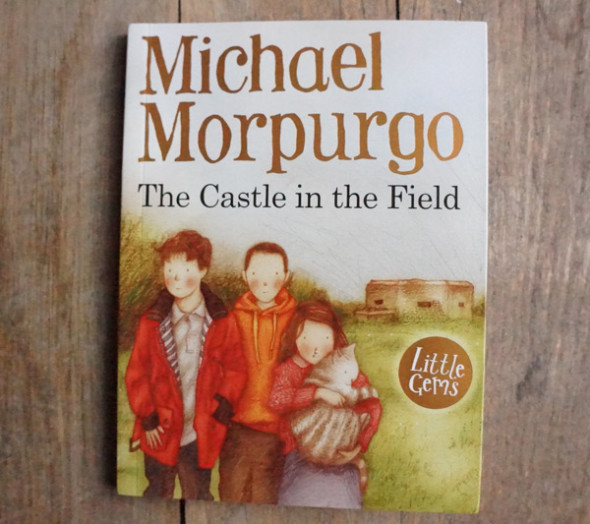 There’s something about hideouts that children just love. Whether it’s a tent in the house or a treehouse or a fun nook, hideouts become magical places for kids to play….and imagine in.
There’s something about hideouts that children just love. Whether it’s a tent in the house or a treehouse or a fun nook, hideouts become magical places for kids to play….and imagine in.
In The Castle in the Field by Michael Morpurgo, three children find their own special hideaway. When they get caught in a downpour, Chris, his younger sister Lisa, and his friend Tom find refuge in a shelter in a field on private property. It’s an abandoned old army guard post built during World War 2, known as a pillbox. As they are trespassing on land owned by ‘old Mr Rafferty’ – who dislikes children – they keep their hideout a secret.
They name the shelter ‘The Castle.’ Soon they are clearing it out and decorating it with pictures and old furniture. For two years ‘The Castle’ remains their hiding place. Often they have to be careful getting to it as old Rafferty’s sheep graze in the field outside it. At one point they’re almost discovered. It’s only when some bullies find their hideout that the game is over.
When I read this wonderful countryside tale, I found myself happily remembering the wonders of secret hideaways when I was a child. I could immediately relate to why the ‘Castle’ was so special to them. Just last week when my kids were home during a school holiday, I helped them build a tent in their bedroom. Soon their tent hideout was filled with books and toys – and I even allowed them to sleep in it for two nights.
I was also impressed on how The Castle in the Field touches upon World War 2 history. Pillboxes are a poignant reminder of the dark days of the war when thousands were built across the British countryside as a defense against a feared invasion by Hitler. Inside this old guard-post the three children even find a helmet with a bullet hole in it. I immediately thought of the soldiers who camped in these mini fortifications with their slit windows waiting for the enemy.
The children also call the field they have to cross to get to the pillbox ‘no-man’s land.’ During the First World War this was often the name given to the land between the frontline trenches.
It’s not surprising that there are references to Britain’s military heritage and World War II as the book is written by Michael Morpurgo. The former British children’s laureate is now probably best known for his children’s novel War Horse. This tells the story of a farm horse used by the cavalry during World War I. It’s also been made into a film by Steven Spielberg and turned into an award-winning play. Many of Morpurgo’s books are set in the First World War.
The illustrations for The Castle in the Field are by the talented Faye Hanson. I’ve written before about her beautiful work as an illustrator.
The Castle in the Field and another book called Snug were especially adapted from Morpurgo’s first book called It Never Rained about the adventures of this group of children in the countryside. They are published as part of Barrington Stoke’s ‘Little Gems’ series of early readers aimed for 5-8s.
 Available on US Amazon and UK Amazon.
Available on US Amazon and UK Amazon.
The illustrations, font and even colour of the paper are specially designed to help and encourage children to read independently while also being dyslexia-friendly. Have a look at Barrington Stoke’s website for more information on why this independent British publisher is attracting so many top children’s authors to write books specially for their young readers.
Disclosure: I was given this copy of The Castle in the Field by Barrington Stoke for an honest review – all opinions are my own. But, I will admit I’m a huge fan of Barrington Stoke. I first discovered them when I bought our first Little Gems book The Snake who Came to Stay by Julia Donaldson. Another recent review was Young Werewolf by Cornelia Funke. (See what I mean about top children’s book authors!)
In the UK, I would recommend visiting with your kids one of the preserved pillboxes – or even a reenactment event involving them – at a National Trust site after reading this book.
After finishing The Castle in the Field, I keep finding myself day dreaming about a wonderful hideaway I made as a child in a bedroom closet. It was a reading nook-of-my-own. Did you have a special hideout during your childhood?

What a lovely book! This is totally reminiscent of my childhood and the secret forts we created in the forest behind our house. I love how the book touches upon the history of World War II in a way that won’t frighten children. Great recommendation for the Kid Lit Blog Hop. Thanks so much for joining us!
This sounds like an interesting read. I’ll keep note of it for when my children are a little older.
That looks great–though I’m more interested in the book for the older kids. I’m going to look for that!
I love Michael Morpurgo and read The Butterfly Lion while I was studying in England actually! I definitely want to read this one–special childhood hideouts represent such a fantastic topic.
In one of my childhood homes, there was a small grove of trees in our back garden that I loved to play in. You could almost be “hidden” once you stepped into what I ended up calling “a secret wood.” 🙂
Thanks for sharing this lovely book!
This looks like a great book. I loved making dens as a child 🙂
Hopping over from the kid lit blog hop.
Thanks Julie. It’s definitely worthwhile looking into the books and authors available from Barrington Stoke.
Kriss, this was a wonderful review. I guess they would call this historical fiction of a sort. It sounds so enchanting, and thanks so much for bringing it to our attention. I have heard of Barrington Stoke, and must go look them up. Thanks for joining us on the Kid Lit Blog Hop
Always terrific to discover a new writer from across the sea. To be honest, I didn’t even know War Horse was a kids’ book, and all these stories look terrific. Thanks for sharing your honest review!
Michael Morpurgo is an amazing children’s author – I can’t wait to read some more of his books to my kids.
How exciting! Thank you so much for sharing a Micheal Morpurgo story. I have become aware of Barrington Stoke through your posts and their books look fantastic. I grew up in Kent along the River Medway and there are pill boxes all over the countryside next to the river in case an invasion were to take place by boat! We played in the pill boxes although they always smelled rather pungent. I will be adding this to my collection of WW2 stories and thank you again for linking up to #kidsbookaweek
Thanks Kirsty. I’m now keen on reading this book to the kids right before we visit a pillbox when we’re back in UK.